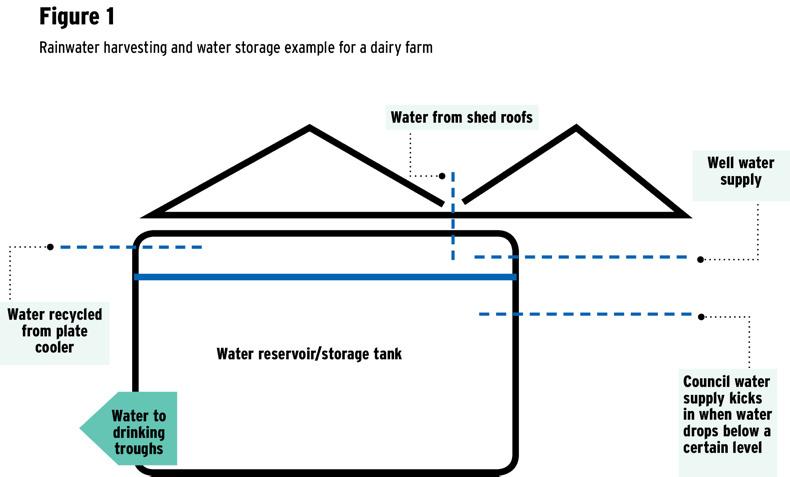Farmers are increasingly becoming interested in rainwater harvesting and water storage. It is not just a case of making use of the water falling on shed roofs to reduce water charges or reduce well water demand.
Rainwater harvesting also enables farmers to keep a reservoir of water on their farms. This means that if water supply fails, there is always a limited supply available which will hopefully be enough to get you by until an alternative arrangement can be made.
Having several water supply options is the best approach to ensure you won’t run out if one supply source fails. In Figure 1, we show the ideal way farmers can make use of rainwater, well water, recycled plate cooler water and council water. In this example, rainwater is used to fill the reservoir tank.

It is also topped up daily from recycled water from a plate cooler. If the level of the water drops below a certain level, the well water kicks in.
If the well water supply fails the council water supply will kick in. This type of system can be installed in any type of storage tank.
Here, we have outlined some common storage options. There are many more storage options available too.
Concrete pre-cast tank
Pre-cast concrete tanks are a quick and easy solution for rainwater harvesting. These tanks can be delivered on site and can be placed either above or below ground. Noel Nolan from Carlow Tanks says water charges and larger herds are fuelling the need to look at all the options available to supply water he believes.
“We have tanks ranging from 1,000-gallon capacity to 8,000 gallons and some farmers double up tanks to increase capacity,” said Noel.
He says their tanks collect the run-off from the roof area, via gutters. The flow is then passed through a filter which removes leaves, twigs and other light debris. The water then flows down into the underground concrete storage tank, through an inlet. “We have software available to size tanks to suit customers. It takes into account the roof area feeding the tank, the demand for water and the part of the country the farm is situated,” explained Noel. A 4,550l (1,000-gallon) tank costs €1,700 excluding VAT and a 36,369l (8,000-gallon) tank costs €6,500 excluding VAT. These costs do not include pipe work leading to the tank or pumps that will be needed to pump water to troughs. Noel says some farmers have set up their tanks so that gravity is the only requirement to fill the water troughs in their sheds.
Plastic tank
Plastic water storage tanks are another option for rainwater harvesting. They are most suited to farms requiring moderate water storage. Multiple tanks can be connected to increase capacity. Tanks can be delivered on-site and are quick to install.
Plastic tanks are usually installed over-ground on a sound base and connected to the gutters. When empty, they can be easily moved. A 10,000l tank weighs 200kg when empty. Mark Burke from JFC says they have a wide range of tanks available for farms. They are made from UV-protected polymer with a life expectancy of 25 years.
“All our tanks come as standard with a 2in and 1.25in British standard pipe (BSP) threaded connection at the base, 4in overflow and access lid with in-built leaf/debris filter basket,” according to Mark. A 10,000l (2,200-gallon) tank costs €1,829 excluding VAT. A 5,700l (1,254-gallon) tank costs €1,422 excluding VAT while a 2,700l (593-gallon) tank costs €772 excluding VAT. Mark says they also provide an optional extra of an automatic mains top up. This acts with a ballcock allowing mains water into the tank if the water level drops below a certain pre-set water level. The 0.75in automatic mains feed costs an additional €80.48 excluding VAT.
Recycling old steel tanks
In the past, we featured a unique way of recycling water using old storage tanks. The two old gun barrel galvanised tanks (pictured here) were once used in a monastery in Roscrea. Together, they can hold 1,000 gallons (4,550l) of water. The farmer set these on concrete block stands and connected them at the base so the two would fill simultaneously. A steel mesh was placed on top to prevent the possibility of anyone, especially a child, falling inside.
The down pipe from the gutter is simply directed into the tank for water collection. Fortunately, there are no trees in the area which limits the amount of debris that can end up in the tanks. Filters could be fitted to prevent this from happening if needs be. The tanks are piped to a wash down pump (the type of pump used in a dairy parlour). It costs approximately €350 to buy the pump.
From there, a series of pipe works were erected around the perimeter of the sheds. Gun barrel piping (1.25in) was used for this because it has a longer lifespan and aesthetically it looks neater. The gun barrel piping costs approximately €20 excluding VAT per 20ft length. A series of quick-release couplings dispersed around the sheds are connected to the gun barrel pipe work. This allows a quick hose connection for cleaning.
Repairing old concrete tanks
This is a 15,000-gallon (68,191-litre) capacity tank that a Laois dairy farmer had in his yard. It is over 30 years old and is built from shuttered, poured concrete. The farmer stopped using this tank because it started leaking over 10 years ago. He had a number of large sheds close to the tank and felt that the water coming from these sheds could be put to use for cleaning down the dairy parlour and collecting yards.
Over the years, due to settling and hard frosts, some considerable cracks started to appear in the walls of the old storage tank which allowed water to leak.
These cracks were repaired using a special polyurethane resin called Webac 1403.
Rainwater is harvested from shed roofs and water also is collected from the plate cooler in the parlour. The tank is topped up by water from the farm well. A float valve regulates the level of the water in the tank and if it falls under a certain level, the well water comes into action.
From the tank, water is pumped to water troughs in the paddocks and the sheds using a regular Lowara pump. Gravity feeds the water from the tank to the dairy parlour. Here, a washdown pump helps to increase the pressure for washing down the parlour.
Read more
Tips to maintain water supply
Farmers are increasingly becoming interested in rainwater harvesting and water storage. It is not just a case of making use of the water falling on shed roofs to reduce water charges or reduce well water demand.
Rainwater harvesting also enables farmers to keep a reservoir of water on their farms. This means that if water supply fails, there is always a limited supply available which will hopefully be enough to get you by until an alternative arrangement can be made.
Having several water supply options is the best approach to ensure you won’t run out if one supply source fails. In Figure 1, we show the ideal way farmers can make use of rainwater, well water, recycled plate cooler water and council water. In this example, rainwater is used to fill the reservoir tank.

It is also topped up daily from recycled water from a plate cooler. If the level of the water drops below a certain level, the well water kicks in.
If the well water supply fails the council water supply will kick in. This type of system can be installed in any type of storage tank.
Here, we have outlined some common storage options. There are many more storage options available too.
Concrete pre-cast tank
Pre-cast concrete tanks are a quick and easy solution for rainwater harvesting. These tanks can be delivered on site and can be placed either above or below ground. Noel Nolan from Carlow Tanks says water charges and larger herds are fuelling the need to look at all the options available to supply water he believes.
“We have tanks ranging from 1,000-gallon capacity to 8,000 gallons and some farmers double up tanks to increase capacity,” said Noel.
He says their tanks collect the run-off from the roof area, via gutters. The flow is then passed through a filter which removes leaves, twigs and other light debris. The water then flows down into the underground concrete storage tank, through an inlet. “We have software available to size tanks to suit customers. It takes into account the roof area feeding the tank, the demand for water and the part of the country the farm is situated,” explained Noel. A 4,550l (1,000-gallon) tank costs €1,700 excluding VAT and a 36,369l (8,000-gallon) tank costs €6,500 excluding VAT. These costs do not include pipe work leading to the tank or pumps that will be needed to pump water to troughs. Noel says some farmers have set up their tanks so that gravity is the only requirement to fill the water troughs in their sheds.
Plastic tank
Plastic water storage tanks are another option for rainwater harvesting. They are most suited to farms requiring moderate water storage. Multiple tanks can be connected to increase capacity. Tanks can be delivered on-site and are quick to install.
Plastic tanks are usually installed over-ground on a sound base and connected to the gutters. When empty, they can be easily moved. A 10,000l tank weighs 200kg when empty. Mark Burke from JFC says they have a wide range of tanks available for farms. They are made from UV-protected polymer with a life expectancy of 25 years.
“All our tanks come as standard with a 2in and 1.25in British standard pipe (BSP) threaded connection at the base, 4in overflow and access lid with in-built leaf/debris filter basket,” according to Mark. A 10,000l (2,200-gallon) tank costs €1,829 excluding VAT. A 5,700l (1,254-gallon) tank costs €1,422 excluding VAT while a 2,700l (593-gallon) tank costs €772 excluding VAT. Mark says they also provide an optional extra of an automatic mains top up. This acts with a ballcock allowing mains water into the tank if the water level drops below a certain pre-set water level. The 0.75in automatic mains feed costs an additional €80.48 excluding VAT.
Recycling old steel tanks
In the past, we featured a unique way of recycling water using old storage tanks. The two old gun barrel galvanised tanks (pictured here) were once used in a monastery in Roscrea. Together, they can hold 1,000 gallons (4,550l) of water. The farmer set these on concrete block stands and connected them at the base so the two would fill simultaneously. A steel mesh was placed on top to prevent the possibility of anyone, especially a child, falling inside.
The down pipe from the gutter is simply directed into the tank for water collection. Fortunately, there are no trees in the area which limits the amount of debris that can end up in the tanks. Filters could be fitted to prevent this from happening if needs be. The tanks are piped to a wash down pump (the type of pump used in a dairy parlour). It costs approximately €350 to buy the pump.
From there, a series of pipe works were erected around the perimeter of the sheds. Gun barrel piping (1.25in) was used for this because it has a longer lifespan and aesthetically it looks neater. The gun barrel piping costs approximately €20 excluding VAT per 20ft length. A series of quick-release couplings dispersed around the sheds are connected to the gun barrel pipe work. This allows a quick hose connection for cleaning.
Repairing old concrete tanks
This is a 15,000-gallon (68,191-litre) capacity tank that a Laois dairy farmer had in his yard. It is over 30 years old and is built from shuttered, poured concrete. The farmer stopped using this tank because it started leaking over 10 years ago. He had a number of large sheds close to the tank and felt that the water coming from these sheds could be put to use for cleaning down the dairy parlour and collecting yards.
Over the years, due to settling and hard frosts, some considerable cracks started to appear in the walls of the old storage tank which allowed water to leak.
These cracks were repaired using a special polyurethane resin called Webac 1403.
Rainwater is harvested from shed roofs and water also is collected from the plate cooler in the parlour. The tank is topped up by water from the farm well. A float valve regulates the level of the water in the tank and if it falls under a certain level, the well water comes into action.
From the tank, water is pumped to water troughs in the paddocks and the sheds using a regular Lowara pump. Gravity feeds the water from the tank to the dairy parlour. Here, a washdown pump helps to increase the pressure for washing down the parlour.
Read more
Tips to maintain water supply







 This is a subscriber-only article
This is a subscriber-only article









SHARING OPTIONS: